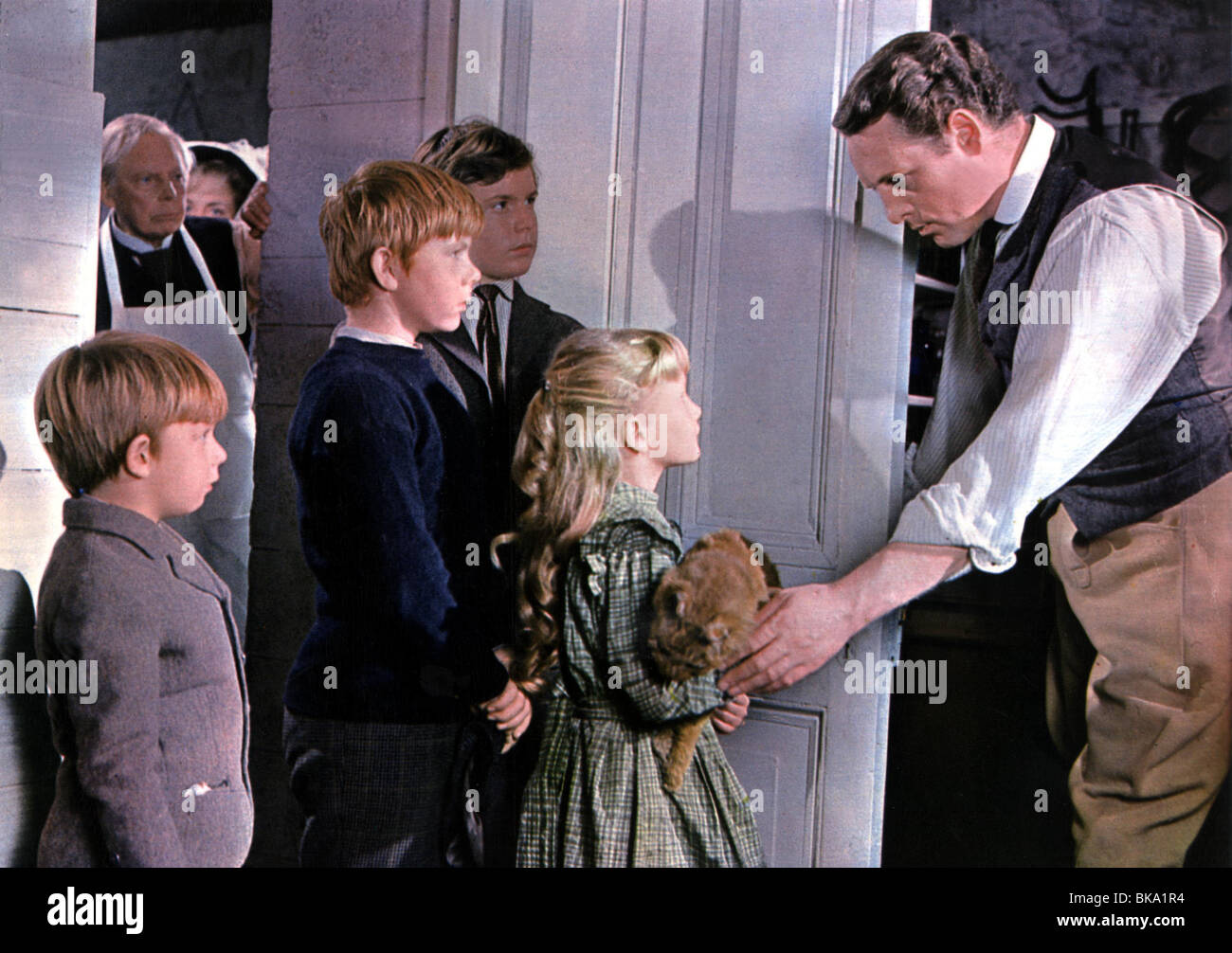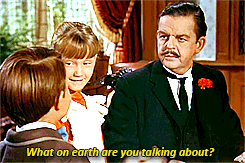Father’s Day is a holiday designed to celebrate
fathers and all that they do to support, inspire, and teach us. Sometimes,
however, Dad has just as many lessons to learn as to teach. This week I’ll be
turning the spotlight on three Disney films that are secretly all about Dad learning a few lessons of his own.
Mary
Poppins: This classic musical claims to be about the magical
adventures of its title heroine, but the greater adventure is the one
undertaken by her employer, George Banks. At the film’s start George returns
home from work gloating about his outwardly perfect home and family. In keeping
with the values of Edwardian England, he demands complete obedience and
propriety from his family, whom he describes as “subjects” in the “lordly life”
he leads. The moment that he opens the front door, however, viewers are shown
just how imperfect the Banks’ home really is. In an effort to establish independence from her confining marriage, Mrs. Banks has devoted herself to the suffragette cause to such
an extent that she is hardly present in her children’s lives. Meanwhile, the
children, Jane and Michael, attempt to gain both of their parents’ attention by
acting out and rebelling against the family’s series of nannies. Rather than
recognizing the ways in which his own behavior may have contributed to his
family’s dysfunction, George instead opts to impose even further restrictions
upon his already stifled wife and children, which naturally leads to the
household becoming the very ‘ghastly mess’ that he was trying to ward off. It
is then that Mary Poppins flies onto the scene to work her magic. Unlike
George, who demands his family’s unquestioning obedience, Mary Poppins earns
Jane and Michael’s respect by treating them with kindness, understanding, and patience.
Similarly, while she does expect the children to follow her rules, she also
instills the value of those rules in them by explaining their purpose. Her infectious
influence also extends to the household staff who begin treating each other
with the same consideration and politeness that she displays towards them. As a
result, she is able to whip the home into the spit spot shape that George
wanted by employing the one tactic that her boss never considered; treating
those around her as people rather than subjects. George is equal parts
mystified and unnerved by this sudden change until he loses his job and realizes
that he was treating his family with the same dismissive lack of empathy that his employers regarded him with. By the film’s conclusion, he is reinstated at
his job, reconciled with his family, and free to return to his old life, albeit with a crucial
change of perspective. By the time that the credits roll, George Banks may not
have become the employee or society man that he wanted to be, but thanks to a
spoonful of sugar and a taste of his own medicine he has become the husband and
father that he needed to be.
 |
| It's not like she doesn't have 8 more lives... |
The Three Lives of Thomasina:
With its meditations upon life, death, grief, and redemption this 1963 film
makes for one of Disney’s most complex and emotionally resonant efforts. The
film follows young Mary Macduhi and her stern veterinarian father, Andrew, as
they struggle to come to grips with the death of Mary’s mother. When grief
leaves her father a cold shadow of his former self, Mary pours all of the
love that she can no longer give to either of her parents into her beloved cat,
Thomasina. Despite working as a veterinarian for years, Andrew sees pets as a
frivolous nuisance and prefers to work with livestock and other ‘useful’
animals. As a result, he feels no remorse after euthanizing an elderly or ill pet, which he sees as an act of mercy. When Thomasina contracts tetanus
during a fight with another cat, he immediately opts to have her euthanized for
fear that the disease could spread, leading to an epidemic. When Mary learns
this devastating news her already strained relationship with her father is
damaged to the point of estrangement. Andrew tries to reconcile with his
daughter, but his every effort is hampered by his inability to understand her
love for Thomasina or show his love for her. When news of Thomasina’s death
reaches the townsfolk his already suspect professional reputation is called
into question. Complicating matters further, word of local recluse Lori
MacGregor’s herbal healing and innate skill with animals spreads throughout the
town, leading Andrew’s clients to begin taking their pets to herfor treatment.
When he finally meets his new rival, he reluctantly realizes that while she
lacks his medical training, his own practice would benefit from her natural
love of and dedication to animals. What Andrew fails to realize, however, is that
Lori is currently treating Thomasina after his assistant failed to properly
euthanize the cat. Through his friendship and eventual romance with Lori, Andrew learns the healing
power of love and is finally able to express his love for Mary and his remorse
at what he believes to be Thomasina’s death. By the film’s conclusion he
realizes that all creatures great and small serve some purpose and are deserving
of the same love and care that we would like to be treated with. When Thomasina
makes a triumphant return to the MacDhui’s, she finds a home where there was
once a house and takes her place in a family that is finally whole.
The Little Mermaid: This
1989 animated musical launched the Disney renaissance with its tale of fathers,
daughters, and the power of letting go. Although the title would suggest that the
film’s focus is upon the headstrong Ariel, the film’s real emotional journey is
the one undertaken by her father, King Trident. At the start of the film widowed
King Trident rules his family with the same firm hand that he rules his kingdom
with, except for his youngest daughter, rebellious Ariel. Although she
constantly breaks with convention and family rules, her charisma and musical
talent make her the clear family favorite. Despite his many indulgences of Ariel, however, he holds firm to one sacred rule; that none of his daughters may
swim to the ocean’s surface, where they could be spotted by humans. In typical
angsty teen fashion, she proceeds to not only break this cardinal rule, but
to test her father even further by interacting with humans and collecting as
many man-made items as she can find. While his anger at discovering his
daughter’s secret treasure trove is justified, King Trident’s reaction is not.
Rather than explaining why his rules are in her best interests, he instead
launches into a bigoted tirade about the inherent evil of all humanity. When
she attempts to argue, he responds with a violent outburst that culminates in
his destroying her beloved collection in its entirety. It is only after Ariel runs
away and seeks help from his arch-enemy, Ursula, that he finally realizes that his
overbearing efforts to protect his daughter only served to drive her away from
him. It is this realization that allows him to reflect upon his ruling and
parenting methods and admit that his actions and reactions are every bit as
important as the intentions behind them. When he finally locates his missing
daughter he puts aside their differences and risks his life and kingdom in
order to ensure her safe return. He faces his ultimate test, however, only after
Ariel has returned home and he is dismayed to find that she despondently
continues to long for the surface world. He then makes the choice to put her
happiness above his own and permanently transforms her into a human. By
returning her to human form King Trident not only allows Ariel to return to her
beloved Prince Eric, but more importantly provides her with the freedom to choose
her own path and find her own happiness. While Ariel may have traded in her
tail for legs, it is her father who undergoes the film’s greatest and most
satisfying transformation as he evolves from iron fisted ruler to open minded father
and leader.



No comments:
Post a Comment